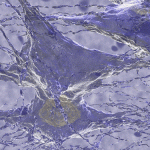
The radical reaction of the rat spinal cord to treatment offers reason to believe that people with spinal cord injury will soon have some options on the horizon. Image: Shutterstock
Previously paralysed rats are able to walk — and run — again.
Half of human spinal cord injuries lead to chronic paralysis. Researchers at Ecole Polytechnique Federale de Lausanne (EPFL) have been able to wake up the spinal brain in rats and restore voluntary movement by using neuroprosthetics — an electronic device used to supplement or replace function to the nervous system — and robot rehabilitation.
The brain and spinal cord have a high rate of neuroplasticity — they are usually able to recover from moderate injury very efficiently. However, with severe injuries the spinal cord expresses almost no neuroplasticity, making recovery almost impossible — until now. Researchers, led by Grégoire Courtine of EPFL have proved that, under certain conditions, plasticity and recovery can take place in these severe cases, but only if the dormant spinal column (what Courtine refers to as the spinal brain) is first woken up.
To do this Courtine and his team injected a chemical solution into the rats, which triggered cell responses by binding to specific receptors located on the spinal neurons. This solution acted to excite neurons and ready them to coordinate lower body movement. After the injection, scientists electronically stimulated the spinal cord with electrodes to send constant electrical signals through nerve fibers to the chemically excited neurons that control leg movement.
All that is left is to initiate that movement. Courtine explain in a 2009 report published in Nature Neuroscience that a stimulated rat spinal column was able to allow previously paralysed individuals to walk involuntarily over treadmills. He concluded that the movement of the treadmill created sensory feedback that initiated walking — the spinal brain took over without any input from the rat’s actual brain.
This led researchers to believe that only a very weak signal from the brain was needed for the animals to initiate movement of their own accord. The researchers wanted to take advantage of the spinal brain and replaced the treadmill with a robotic vest that supported the rats on their hind legs and enabling them to move forward. The robotic devices only came into play when the rats lost balance, giving them the impression of having a healthy and working spinal column, encouraging them towards a reward. What they found changed their understanding of the central nervous system.
“Our results were highly unexpected, after two to three weeks the rats were already able to perform one or two steps voluntarily,” says Courtine. “When we compared the spinal cord before and after rehabilitation, there was a complete reorganisation of neural circuits. New fibers had formed around the lesion completely separate to the original damaged ones.”
Rats are used to model most spinal cord injuries, as their muscle organisation is very similar to humans. With increased time and training, the rats capabilities grew, and at six to seven weeks the rats were not only able to walk, but even managed to sprint up stairs or step over a low obstacle to get to a chocolate reward.
“The results show tremendous potential for neuroplasticity. It is extremely important to create a condition to promote the communication of information between the brain and spinal cord,” Courtine explains. “This suggests that a similar method may be effectively applied to paralysed humans as a result of severe spinal cord injuries.”






